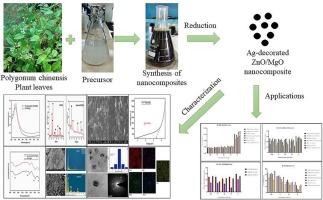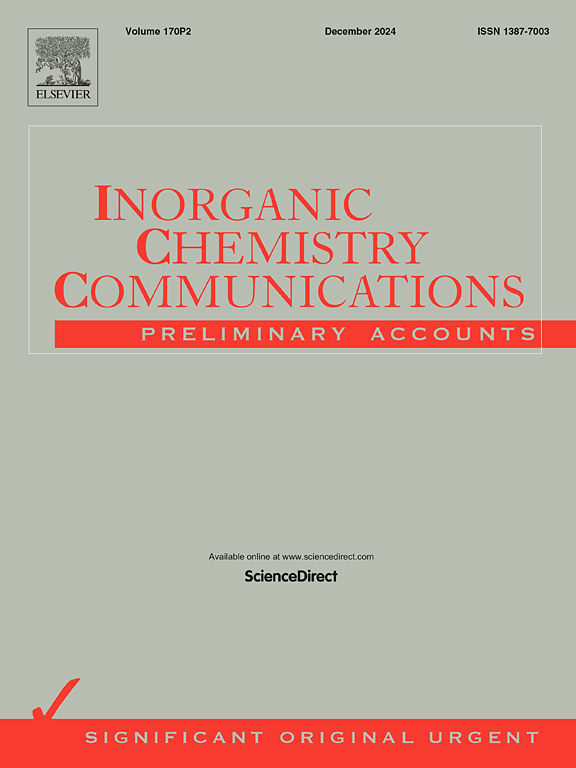Synthesis and characterization of Ag-decorated ZnO/MgO nanocomposite using a novel phyto-assisted biomimetic approach for anti-microbial and anti-biofilm applications
IF 4.4
3区 化学
Q1 CHEMISTRY, INORGANIC & NUCLEAR
引用次数: 0
Abstract
The synthesis of nanoparticles using plant extracts presents an innovative alternative to traditional chemical or physical methods. Natural nanoparticle synthesis using plant extracts has several advantages over traditional methods, including less reliance on synthetic chemicals, a reduced environmental impact, the potential to synthesize unique nanoparticle characteristics, and the production of biocompatible and biodegradable materials. This strategy is a sustainable and effective alternative. The antimicrobial activity of Ag-decorated ZnO/MgO from the leaves extract of Polygonum chinensis has been demonstrated in the present work. UV–vis, XRD, FTIR, and SEM-EDX were used to assess the bio-synthesized nanocomposite after the effective synthesis of Ag-decorated ZnO/MgO nanocomposite. The UV spectrum of the synthesized Ag-decorated ZnO/MgO nanocomposite showed a peak at 225 nm, with a band gap energy of 4.30 eV. The nanocomposite was confirmed with irregular flakes-like structure with range in size from 70 to 150 nm using SEM analysis. Standardized tests used in antimicrobial analysis were used to investigate the antimicrobial activity of Ag-decorated ZnO/MgO nanocomposite against various microorganisms. Biofilm inhibition studies confirmed the nanocomposite’s inhibitory effect on various bacteria. The findings indicated that Ag-decorated ZnO/MgO nanocomposite is a promising antimicrobial and antifilm agent.

利用新型植物辅助生物仿生方法合成银饰氧化锌/氧化镁纳米复合材料并确定其特性,用于抗微生物和抗生物膜应用
利用植物提取物合成纳米粒子是传统化学或物理方法的创新替代方法。与传统方法相比,利用植物萃取物合成天然纳米粒子具有多种优势,包括减少对合成化学品的依赖、降低对环境的影响、合成独特纳米粒子特性的潜力以及生产生物兼容和可生物降解的材料。这种策略是一种可持续的有效替代方法。本研究证明了从何首乌叶提取物中提取的银饰 ZnO/MgO 的抗菌活性。在有效合成了银饰 ZnO/MgO 纳米复合材料后,使用紫外可见光谱、XRD、傅立叶变换红外光谱和 SEM-EDX 对生物合成的纳米复合材料进行了评估。合成的银饰 ZnO/MgO 纳米复合材料的紫外光谱在 225 纳米处出现峰值,带隙能为 4.30 eV。通过扫描电镜分析,确认该纳米复合材料具有不规则的片状结构,尺寸范围为 70 至 150 nm。抗菌分析中使用的标准化测试用于研究银饰 ZnO/MgO 纳米复合材料对各种微生物的抗菌活性。生物膜抑制研究证实了纳米复合材料对各种细菌的抑制作用。研究结果表明,银饰氧化锌/氧化镁纳米复合材料是一种很有前景的抗菌剂和抗膜剂。
本文章由计算机程序翻译,如有差异,请以英文原文为准。
求助全文
约1分钟内获得全文
求助全文
来源期刊

Inorganic Chemistry Communications
化学-无机化学与核化学
CiteScore
5.50
自引率
7.90%
发文量
1013
审稿时长
53 days
期刊介绍:
Launched in January 1998, Inorganic Chemistry Communications is an international journal dedicated to the rapid publication of short communications in the major areas of inorganic, organometallic and supramolecular chemistry. Topics include synthetic and reaction chemistry, kinetics and mechanisms of reactions, bioinorganic chemistry, photochemistry and the use of metal and organometallic compounds in stoichiometric and catalytic synthesis or organic compounds.
 求助内容:
求助内容: 应助结果提醒方式:
应助结果提醒方式:


